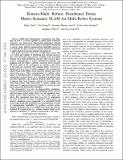Kimera-Multi: Robust, Distributed, Dense Metric-Semantic SLAM for Multi-Robot Systems
Author(s)
Tian, Yulun; Chang, Yun; Herrera Arias, Fernando; Nieto-Granda, Carlos; How, Jonathan; Carlone, Luca; ... Show more Show less
DownloadAccepted version (17.06Mb)
Open Access Policy
Open Access Policy
Creative Commons Attribution-Noncommercial-Share Alike
Terms of use
Metadata
Show full item recordAbstract
This paper presents Kimera-Multi, the first multi-robot system that (i) is
robust and capable of identifying and rejecting incorrect inter and intra-robot
loop closures resulting from perceptual aliasing, (ii) is fully distributed and
only relies on local (peer-to-peer) communication to achieve distributed
localization and mapping, and (iii) builds a globally consistent
metric-semantic 3D mesh model of the environment in real-time, where faces of
the mesh are annotated with semantic labels. Kimera-Multi is implemented by a
team of robots equipped with visual-inertial sensors. Each robot builds a local
trajectory estimate and a local mesh using Kimera. When communication is
available, robots initiate a distributed place recognition and robust pose
graph optimization protocol based on a novel distributed graduated
non-convexity algorithm. The proposed protocol allows the robots to improve
their local trajectory estimates by leveraging inter-robot loop closures while
being robust to outliers. Finally, each robot uses its improved trajectory
estimate to correct the local mesh using mesh deformation techniques.
We demonstrate Kimera-Multi in photo-realistic simulations, SLAM benchmarking
datasets, and challenging outdoor datasets collected using ground robots. Both
real and simulated experiments involve long trajectories (e.g., up to 800
meters per robot). The experiments show that Kimera-Multi (i) outperforms the
state of the art in terms of robustness and accuracy, (ii) achieves estimation
errors comparable to a centralized SLAM system while being fully distributed,
(iii) is parsimonious in terms of communication bandwidth, (iv) produces
accurate metric-semantic 3D meshes, and (v) is modular and can be also used for
standard 3D reconstruction (i.e., without semantic labels) or for trajectory
estimation (i.e., without reconstructing a 3D mesh).
Date issued
2022Department
Massachusetts Institute of Technology. Laboratory for Information and Decision SystemsJournal
IEEE Transactions on Robotics
Publisher
Institute of Electrical and Electronics Engineers (IEEE)
Citation
Tian, Yulun, Chang, Yun, Herrera Arias, Fernando, Nieto-Granda, Carlos, How, Jonathan et al. 2022. "Kimera-Multi: Robust, Distributed, Dense Metric-Semantic SLAM for Multi-Robot Systems." IEEE Transactions on Robotics, 38 (4).
Version: Author's final manuscript